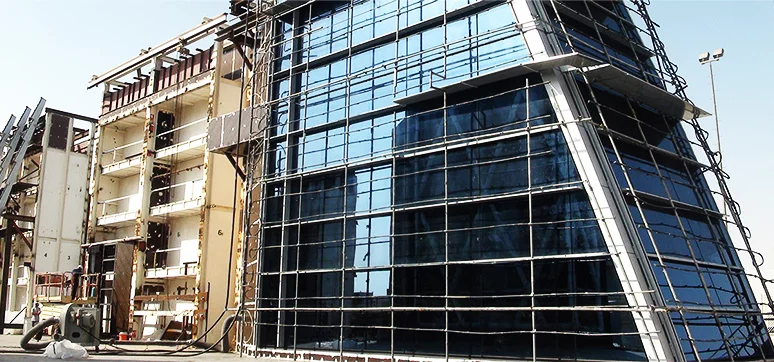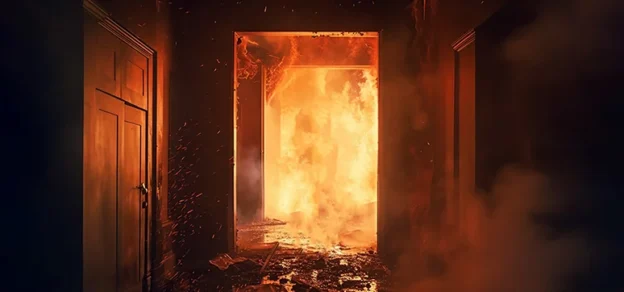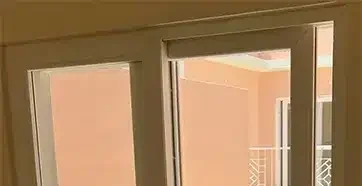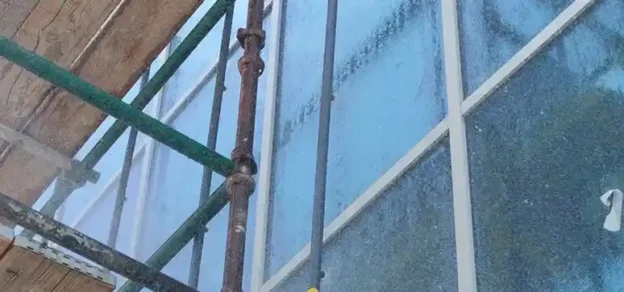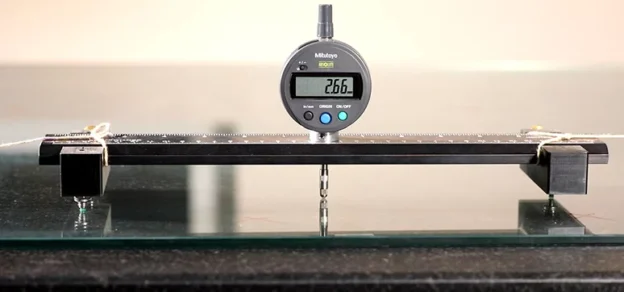Introduction:
Windows and curtain walls generally represent as much as 50% to 100% of the exterior cladding of large buildings and are determining elements in the performance of the vertical building envelope. They are a critical and important architectural feature of a building and represent a significant portion of the overall cost of building construction. Given the ever-growing complexity and variety of modern building envelopes, the evaluation of their performance, in terms of structural integrity and durability as well as comfort requirements, in the pre-construction and construction phase is essential in order to avoid undesirable and costly problems during the service life of the building.
Before we delve deeper into the fundamentals of façade testing, let’s review the basics of glazed curtain wall designs.
Curtain Wall Design
Monumental glazed curtain wall systems are normally factory-fabricated assemblies that can be shipped to the job site — either as pre-assembled panels (unitized) or in knocked-down form for onsite assembly (stick). Aluminium is invariably the most popular choice of framing material accounting for its versatility, ease of fabrication and light weight. Glazing choices include a myriad of glass products as well as composite panels, solid panels or even stone.
Common Performance Anomalies
Performance requirements need to be established for each project on a case-by-case basis, based on building height and geographic location, exterior and interior design parameters, as well as the type of building occupancy.
The most commonly experienced performance anomalies that often result in a complete replacement or expensive restoration/maintenance activities are as follows:
- Any form of water infiltration to the interior side of a building
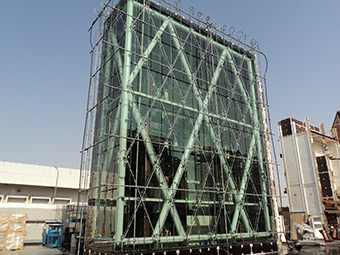 Excessive air leakage resulting in discomfort to building occupants
Excessive air leakage resulting in discomfort to building occupants- Structural load failure
- Thermal discomfort
- Condensation
Therefore the primary performance requirements are needed to be established in the design phase of each project separately.
Where does Façade Testing Come in Picture:
Building envelopes are exposed to climatic changes which could result in potential deterioration and resultant failures. Thus the façade component must be in real-time tested to ensure safety, stability and durability. The design and construction as well as the material components should meet strict standards and should be tested in accordance. This shall ensure safety and impeccable performance and reduce the risk of losing crores of rupees on the repair of water-damaged interiors and reconstruction and restoration of leaking facades.
Importance of Facade Testing:
As is the golden rule for all the things important in life – Prevention is better than Cure – so is the importance of façade testing.
A timely and well-planned façade performance test –
- Ensures the safety of the public and occupants of the building by identifying and ensuring the structural and seismic stability
- Is necessary to evaluate and validate the design of the façade
- Identifies and points out fabrication errors, air leakage, and water leakage if any
- Helps in rectifying all faults before final production
- Saves cost and time
- Ensures a quality façade
Industry Standards
There is no mandatory standard in India for the performance of curtain walls. There is a dire need to formalize the codes which shall function as a benchmark in assessing the proposed design to ascertain whether the facade meets the tender specification and would withstand the test of time without compromising on its performance. Nonetheless, depending on the façade consultant, each project follows American, European, Australian or a combination of codes. While most of the parameters are the same, there are variations in terms of testing methodology and acceptable parameters.
Types of Tests
Testing representative segments of curtain walls, or windows, for example, comprises three basic tests, plus three others.
The Basic Tests:
- Air infiltration test
- Water penetration test
- Structural load test
The Additional Tests:
- The Dynamic water penetration test
- The seismic test
- The thermal cyclic test
Besides these, a curtain wall can be tested for fire performance as well depending on the individual need and requirement
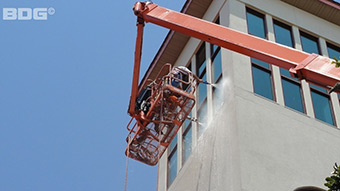
Laboratory Test Mock-Ups
In most projects of any significance, the performance of the window and curtain wall systems which are to form part of the building envelope are evaluated in an accredited testing laboratory prior to construction.
The test mock-ups simulate the exact conditions that the actual façade at the site may face and a similar structural, wind and water environment is created. Then the mock-up is subjected to the test as per the requirements stated above for each category of test. The test mock-up should be based on the complexity of any given detail or condition as well as the frequency at which a given detail or condition is repeated for a project
Characteristics of a Test Mock-Up:
The test area for metal and glass curtain walls must incorporate all the essential components in order to be representative.
- The test area should be at least three glass bays wide so as to incorporate a central bay that incorporates all the junction details.
- In the case of a unitized curtain wall system, a vertical module joint should also be included within the test area.
- The height of the test area should include at least one expansion or stack joint, at least one spandrel section and one vision section.
- Typically, the height of the test area should be at least one full floor storey high.
In this segment, we shall understand the fundamentals of the three basic tests for curtain walls – Air infiltration, Water permeability and Structural load.
The test methods and standards outlined here are as per ASTM guidelines.
Air Infiltration Test
Test Method:
Typically a pressure differential must be created across the test specimen in order to simulate wind pressure. In order to create the required pressure differential, a test chamber is erected on the interior side of the test specimen.
The test pressures are typically specified by the project architect and are different for the air infiltration/exfiltration test and the water penetration test. The air infiltration/exfiltration test is normally undertaken at a pressure differential of 1.57 psf (75 Pa) or 6.24 psf (300 Pa).
Air Infiltration
| Code/Standard | ASTM E283 | AS/NZS 4284 |
|---|---|---|
| Air Infiltration Test | +75 Pa or -75 Pa | +150 Pa or -150 Pa |
| Pass Criteria | 1.8 m3/h.m2 * | 5.76m3/h/m2 (1.6 L/s/m2) |
*Recommended by AAMA (American Architectural Manufacturers Association)
The allowable air leakage rates are usually indicated in the architectural specifications and will vary depending on the codes followed and whether it’s a fixed or an openable section.
Water Penetration Test:
Test Method:
The water penetration resistance test consists of sealing a chamber to the interior or exterior face of the test specimen to be tested, supplying or exhausting air to the chamber at the rate required to maintain the desired air pressure difference across the specimen. Simultaneous to the application of air pressure difference, water shall be applied to the exterior face at the required rate (Tables 2 and 3) while observing for any water penetration at the interior.
For the water penetration resistance test, a calibrated sprinkler rack is hung on the exterior side of the test specimen in order to apply a continuous and uniform water spray. It is important to have sufficient and constant water pressure
Water penetration tests can be of the following types –
- Static water penetration test
- Dynamic water penetration test (additional test)
Static Water Penetration
| Code/Standard | ASTM E331 | AS/NZS 4284 |
|---|---|---|
| Static Water Penetration Test | >137 Pa | > 300 Pa or .3 Ws |
| Water spray requirement | >3.4 l/min.m2 | >3.0 l/min.m2 |
| Duration of test | 15 minutes | 15 minutes |
| Pass Criteria | There shall be no water leak during the test | There shall be no water leak during the test |
We know the test is failed if:-
- Water appears on the inside face of the specimen and is visible from an occupied space
- Water appears on the inside face of the specimen and is likely to damage insulation or architectural fixtures
- There is water leakage that is not contained and drained away within the test period
Structural Performance Test:
Test Method:
Structural performance testing consists of utilising a test chamber located on the interior or exterior of the specimen. Air is evacuated or supplied from/to the chamber to create the required pressure differential and the specimen is tested according to maximum deflection limits or audible, tactile, or visual indications of material or assembly distress or failure.
Structural Performance
| Code/Standard | ASTM E330 | AS/NZS 4284 |
|---|---|---|
| Structural performance test | Design wind pressure | Design wind pressure |
| Deflection | L/175 | L/250 or 20 mm whichever is less. Successive member displacement shall not exceed 3mm |
| Structural proof load test | 150% of the design wind pressure | Ultimate limit state (normally 150% of design wind pressure) |
| Pass Criteria | No Failure | No Failure |
*Recommended by AAMA
- Maximum deflection shall be limited to L/175 for spans up to 4115 m
- For Span greater than 4115 m but less than 12.2 m, maximum deflection shall be limited to L/240 + 6.35 mm
** Recommended by AAMA
- Permanent deformation shall not exceed .2% of the clear span
Façade testing should become a normal procedure and part of the façade design – bid – build process. Façade testing in vitro and then periodic field testing considerably reduces the risk of failures in façades
Acknowledgement:
The article was reviewed by Winwall Technology Pvt. Ltd. For any technical queries, please get in touch with
Mr. Jothi Ramalingam at winwalltechindia@gmail.com | +91 9841020620
References:
- Importance and Types of Façade Testing – presentation by Simon Chin
(Zak World of Façades) - AIA Journal of Curtain Wall Failures
- Applicable lab and field testing
(Archtest.com) - Evaluating field performance of windows and curtainwalls
(Mario D. Goncaslves, Robert Jutras) - Principles of Curtain Walling
(Kawneer white paper)
